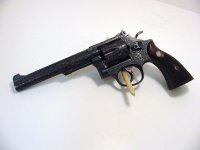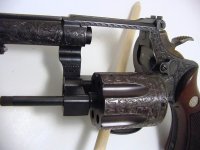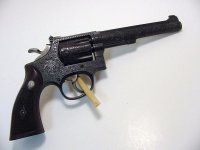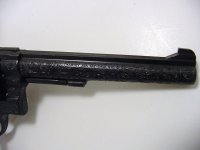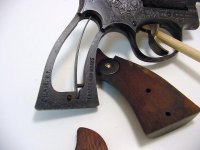This is my maiden voyage on any forum. Boy there are a lot of buttons on this page. You are always helpful and friendly so I thought I would ask about a gun I picked up 2 weeks ago. It is a model 17 with "Harvey .224 KAY-CHUK" on the barrell. The barrell is 6" long and the serial # starts K380XXX. I have no idea who engraved it or what it is worth. I traded some very nice Case knives for it. Read about all the post I could find on this and Gunbroker on the Harvey KAY-CHUK. I have some pics of the gun, it is great looking. I have filled out the request for a letter of Authenticity from Mr. Roy Jinks and will be sending that out this week. Thanks
You are using an out of date browser. It may not display this or other websites correctly.
You should upgrade or use an alternative browser.
You should upgrade or use an alternative browser.
Engraved mod-17 Harvey .224 KAY-CHUK
- Thread starter rdbstuff
- Start date
Register to hide this ad
Sebago Son
Member
Beautiful K-22.
Really nice, tasteful engraving. Well executed. As you may have guessed this is not a factory conversion to the K-Chuck so I doubt that the Letter will tell you uch beyond where and when it shipped when it was still a .22 Long Rifle..
Really nice, tasteful engraving. Well executed. As you may have guessed this is not a factory conversion to the K-Chuck so I doubt that the Letter will tell you uch beyond where and when it shipped when it was still a .22 Long Rifle..
Welcome to the forum! I am not the one to advise on value and whose work is on your revolver. I am sure others will chime in on that. I believe yours is a 1959 model and is certainly nice looking!
- Joined
- Dec 17, 2008
- Messages
- 6,619
- Reaction score
- 1,209
very nice indeed!
gjamison
Member
welcome to the forum, nice first post and a great gun. do you
have a factory letter?
have a factory letter?
rburg
Member
I've got a few engraved K22s. I like them. Yours has what we call deep relief engraving. The factory work is much lighter. There was an engraver in Indiana named Ben Shostle who specialized in it for years and years. I believe he's passed away, but his work lives on. I've had a few of his other guns in the past, and each was a work of art.
We don't have a resident expert on engraving here. I wish we did.
There is an engravers guild, kind of a club or association for those currently in the business. Some of those people can give you clues as to who the craftsman was. Of course you've got your hint on the grip frame, so you need to contact them.
About 5 or 6 years ago my gunshow partner gave me a courtesy call from down state. He'd made is stop at "our" gunshop while passing through to visit his daughter. The courtesy call was to tell me I had a gun on layaway, and I needed to take off work, stop at the bank, and withdraw a bunch of money to bail it out. Friends are nice to have. He not only spent all his money, he worked at spending mine, too.
But he was a pretty smart guy, knew what I needed, so he helped me out. When I was so impolite as to ask what I'd just bought, he said it was one of those lemons, the ones no one wanted. Thanks, John.
When I was so impolite as to ask what I'd just bought, he said it was one of those lemons, the ones no one wanted. Thanks, John.
But when I got there on Saturday, he was right about me needing it. The ugly duckling was a postwar 38/44 Heavy Duty. Engraved nearly to death, then they hammered silver wire into every available flat place. The problem was tarnish over the years had discolored the inlay until it was the same color black as the gun. Still, I've had years of experience polishing the family silverware, so when I got it home, I got out the silver polish. Wow did it stand out.
So I took it to a gun show and located my friendly local engraver, Jeff Flannery. Engravers have a funny way of looking at guns. I've seen David Carroll, one of our members here, do the same thing. They kind of hold it by the barrel and bottom corner of the grip frame. Then they gently rotate it, looking at every square inch of the gun, multiple times.
In my situation, he was looking for an engravers mark. A little hidden secret is almost all engravers put their mark on guns. Even factory guns where they're not supposed to, they still often do it, concealed, but there. Jeff's an honest guy, and he'll tell you the truth even if it hurts. But after telling me he had no idea, he smiled and said "here's a guy coming up the aisle who can tell us." He introduced me to the current President of the Engravers Guild." He then took his good natured time examining the gun in detail. In the end, he didn't know either. But he
eased my pain by telling me "If he's not a member of the guild, he sure as hell should be."
So my advice to the OP here is to really examine the gun. under the barrel, around the sideplate and around the frame. I'm going to guess you've got all the information you're going to get from the grip frame.
And now a hint on gun care: Its a work of art, but it does require a little more and different care than a plain gun. Each of the tool cuts adds a lot of surface area to the gun. You need good oil worked down into those places. The best tool for that work is a camel hair brush. No, they don't skin camels to obtain the hair, its squirrel hair. But a decent quality brush, available at any art supply store will last forever. Use good oil. For my engraved guns I prefer CLP Collectors. Its the same quality product, its just thicker and kind of dries to a waxy compound. If you slather it on and spread it with the brush, making sure you get each cut (a lot of them, I know), you'll protect the gun for a long time.
But a decent quality brush, available at any art supply store will last forever. Use good oil. For my engraved guns I prefer CLP Collectors. Its the same quality product, its just thicker and kind of dries to a waxy compound. If you slather it on and spread it with the brush, making sure you get each cut (a lot of them, I know), you'll protect the gun for a long time.
On the .224 Harvey Kachuck, its just a wildcat center fire that was popular back in the '50s and '60s. It was made obsolete by the introduction of the M53 .22 Jet. It had about the same performance, but the Jet was available over the counter.
We don't have a resident expert on engraving here. I wish we did.
There is an engravers guild, kind of a club or association for those currently in the business. Some of those people can give you clues as to who the craftsman was. Of course you've got your hint on the grip frame, so you need to contact them.
About 5 or 6 years ago my gunshow partner gave me a courtesy call from down state. He'd made is stop at "our" gunshop while passing through to visit his daughter. The courtesy call was to tell me I had a gun on layaway, and I needed to take off work, stop at the bank, and withdraw a bunch of money to bail it out. Friends are nice to have. He not only spent all his money, he worked at spending mine, too.
But he was a pretty smart guy, knew what I needed, so he helped me out.
But when I got there on Saturday, he was right about me needing it. The ugly duckling was a postwar 38/44 Heavy Duty. Engraved nearly to death, then they hammered silver wire into every available flat place. The problem was tarnish over the years had discolored the inlay until it was the same color black as the gun. Still, I've had years of experience polishing the family silverware, so when I got it home, I got out the silver polish. Wow did it stand out.
So I took it to a gun show and located my friendly local engraver, Jeff Flannery. Engravers have a funny way of looking at guns. I've seen David Carroll, one of our members here, do the same thing. They kind of hold it by the barrel and bottom corner of the grip frame. Then they gently rotate it, looking at every square inch of the gun, multiple times.
In my situation, he was looking for an engravers mark. A little hidden secret is almost all engravers put their mark on guns. Even factory guns where they're not supposed to, they still often do it, concealed, but there. Jeff's an honest guy, and he'll tell you the truth even if it hurts. But after telling me he had no idea, he smiled and said "here's a guy coming up the aisle who can tell us." He introduced me to the current President of the Engravers Guild." He then took his good natured time examining the gun in detail. In the end, he didn't know either. But he
eased my pain by telling me "If he's not a member of the guild, he sure as hell should be."
So my advice to the OP here is to really examine the gun. under the barrel, around the sideplate and around the frame. I'm going to guess you've got all the information you're going to get from the grip frame.
And now a hint on gun care: Its a work of art, but it does require a little more and different care than a plain gun. Each of the tool cuts adds a lot of surface area to the gun. You need good oil worked down into those places. The best tool for that work is a camel hair brush. No, they don't skin camels to obtain the hair, its squirrel hair.
On the .224 Harvey Kachuck, its just a wildcat center fire that was popular back in the '50s and '60s. It was made obsolete by the introduction of the M53 .22 Jet. It had about the same performance, but the Jet was available over the counter.
rdbstuff:
Neat gun! The engraving looks to be very good and of high quality. I would guess the engraving was done after the K-Chuck conversion based on the barrel markings reflecting the conversion. I am not aware of any other K-Chucks that were engraved!
Bob
Neat gun! The engraving looks to be very good and of high quality. I would guess the engraving was done after the K-Chuck conversion based on the barrel markings reflecting the conversion. I am not aware of any other K-Chucks that were engraved!
Bob
MAG-NUM
Member
RDB that is a beautiful example of the fine art of engraving. You made a fantastic trade in my opinion.
Dick, fascinating information. What a great place to learn. Thanks, Bob
Dick, fascinating information. What a great place to learn. Thanks, Bob
Very nice revolver. I agree the engraving had to come along after the conversion.
I wonder if that is south-of-the-border work? The eagle with snake is invariably a Mexican motif in my experience, though it usually involves cactus as part of the scene. That seems to be missing in the image on the sideplate, but perhaps there just wasn't enough room to deal with every component of the legend. Does anyone know of snake and eagle imagery in non-Mexican engraving?
I wonder if that is south-of-the-border work? The eagle with snake is invariably a Mexican motif in my experience, though it usually involves cactus as part of the scene. That seems to be missing in the image on the sideplate, but perhaps there just wasn't enough room to deal with every component of the legend. Does anyone know of snake and eagle imagery in non-Mexican engraving?
The scroll work looks German or Austrian,,or at least done by someone who learned from an engraver from there. The work was done after the conversion I suspect from the way it is wrapped around the (registered trade marked) bbl markings.
Many engravers from Europe came to the US after WW2 as there was at least a working economy here along with a market.
Many that stayed in Europe found work from some of the larger enterprises like Kurt Jaeger. His firm did alot of work for US gunsmiths, dealers and collectors. Their market in Germany after WW2 was limited early on the US Occupation personel.
Most all the work from his shop will be marked with the 'Kurt Jaeger-Mainz' name, though he had some of the best of the German engravers working for him,,Willig amoung them. Erich Boessler may have even engraved for them after the War too.
There are many freelanse engravers in that era that cut in that scroll style.
Most all would have signed their work, though it can be sometimes small and difficult to see.
Beautiful revolver! Relief work is time consuming.
Many engravers from Europe came to the US after WW2 as there was at least a working economy here along with a market.
Many that stayed in Europe found work from some of the larger enterprises like Kurt Jaeger. His firm did alot of work for US gunsmiths, dealers and collectors. Their market in Germany after WW2 was limited early on the US Occupation personel.
Most all the work from his shop will be marked with the 'Kurt Jaeger-Mainz' name, though he had some of the best of the German engravers working for him,,Willig amoung them. Erich Boessler may have even engraved for them after the War too.
There are many freelanse engravers in that era that cut in that scroll style.
Most all would have signed their work, though it can be sometimes small and difficult to see.
Beautiful revolver! Relief work is time consuming.
Last edited:
Bennett Gun Works
The Bennett Gun Works is the company that bought the rights to the K-Chuk from Jim Harvey. They roll marked there conversions. However the roll mark on my gun is a little different. The original owner of my gun filled the roll marks with gold fill so it stands out more.

I don't believe the engraving was done by Bennett! I don't believe a factory letter will help you much with this gun as the conversion and engraving was probably done after the gun was shipped!
jcelect SWCA#LM723
The Bennett Gun Works is the company that bought the rights to the K-Chuk from Jim Harvey. They roll marked there conversions. However the roll mark on my gun is a little different. The original owner of my gun filled the roll marks with gold fill so it stands out more.

I don't believe the engraving was done by Bennett! I don't believe a factory letter will help you much with this gun as the conversion and engraving was probably done after the gun was shipped!
jcelect SWCA#LM723
Just another thought.
Roy Vail had his shop down in Warwick NY from the 40's through the 70's.
He dealt in high grade firearms, building custom guns and did some of the engraving as well. He, like many of the better 'smiths involved with high grade guns (and their customers!) of that time period did have connections with engravers (as well as gunsmiths and dealers/manufacturers) in Europe. He was and still is a well known name in the custom gun field.
Just speculation of course,,but being reletively close to each other, it's a possibility that the engraving job was done out of Vail's shop. Either done 'in house' or sent to Europe to be done by one of his contacts there.
Roy Vail had his shop down in Warwick NY from the 40's through the 70's.
He dealt in high grade firearms, building custom guns and did some of the engraving as well. He, like many of the better 'smiths involved with high grade guns (and their customers!) of that time period did have connections with engravers (as well as gunsmiths and dealers/manufacturers) in Europe. He was and still is a well known name in the custom gun field.
Just speculation of course,,but being reletively close to each other, it's a possibility that the engraving job was done out of Vail's shop. Either done 'in house' or sent to Europe to be done by one of his contacts there.
feralmerril
Absent Comrade
Just a couple thoughts or questions. As I recall those conversions were done in the 1950s or so. Wasnt the K chuck a hornet conversion? Next, the model 53 jet is close to the same idea. How were the K-chucks converted to center fire. Is there a off chance a guy could get a 53 hammer and have the gun reworked to shoot both rim and center fire like the 53? Then get a standard 17 clyinder and have that prize shoot both like the 53, or even get some machinest to make inserts like the 53?
Change the K-Chuk? ? ?
Hey feralmerril
Anything is possible if you have enough money! Jim Harvey made a gun equal to or better than the Jet(before the Jet came out)! However he did not do it the easy way! Harvey converisions were made on rim fire frames by changing the firing pin only! The original rim fire hammer was used and the firing pin was changed to an offset pin and installing a center fire nose bushing in the frame. The Jet has two firing pins and a switch on the hammer! The 22 Hornet is the parent cartridge of the K-Chuk! The Hornet case is shortened by .050" and then fire formed to the K-Chuk.

jcelect SWCA#LM723
Hey feralmerril
Anything is possible if you have enough money! Jim Harvey made a gun equal to or better than the Jet(before the Jet came out)! However he did not do it the easy way! Harvey converisions were made on rim fire frames by changing the firing pin only! The original rim fire hammer was used and the firing pin was changed to an offset pin and installing a center fire nose bushing in the frame. The Jet has two firing pins and a switch on the hammer! The 22 Hornet is the parent cartridge of the K-Chuk! The Hornet case is shortened by .050" and then fire formed to the K-Chuk.

jcelect SWCA#LM723
feralmerril
Absent Comrade
I already own a 53 jet, have ammo and dies. I have loaded for it but havent messed with it in many years. I also have a 1937 first year winchester 70 in .22 hornet that somebody before me reamed out to K-hornet. I didnt know it was rechambered when I bought it, but kept it and bought K-hornet dies for it too.
One of my old favorites is .256 win mag. I once owned a rare ruger hawkeye that got me started, bought the dies and even had a martini built up in it. Loved that cartridge! Foolishly sold both of those, but I have a barrel in .256 for my T/C and the dies and ammo. I really would like one of those marlin 62s in one. That, or better yet have a winchester 92 converted to one. Maybe someday I will convert a rossi 92 to .256.
One of my old favorites is .256 win mag. I once owned a rare ruger hawkeye that got me started, bought the dies and even had a martini built up in it. Loved that cartridge! Foolishly sold both of those, but I have a barrel in .256 for my T/C and the dies and ammo. I really would like one of those marlin 62s in one. That, or better yet have a winchester 92 converted to one. Maybe someday I will convert a rossi 92 to .256.
I too have a Harvey Kay-Chuk.
Mine is marked on the barrel "Harvey .224 Kay-Chuk Std" with the registered trademark symbol.
It is a Model 48, SN K3870xx
I bought it out of Shotgun News around 1974. It came with custom dies, a gauge for loaded rounds and sized cases. Several hundred sized and lubricated gas checked cast bullets, two or three hundred loaded rounds and about the same number of empty cases. I think mine marked "Std" indicates it's not the full blown Kay-Chuk round but closer to a shortened .22 Hornet.
Fun gun to shoot although I don't shoot it often.
JLK
Mine is marked on the barrel "Harvey .224 Kay-Chuk Std" with the registered trademark symbol.
It is a Model 48, SN K3870xx
I bought it out of Shotgun News around 1974. It came with custom dies, a gauge for loaded rounds and sized cases. Several hundred sized and lubricated gas checked cast bullets, two or three hundred loaded rounds and about the same number of empty cases. I think mine marked "Std" indicates it's not the full blown Kay-Chuk round but closer to a shortened .22 Hornet.
Fun gun to shoot although I don't shoot it often.
JLK
- Joined
- Mar 17, 2005
- Messages
- 26,096
- Reaction score
- 46,829
Great gun. You are off to a great start! Welcome aboard.
Some of the members have done a bit of research on those guns.
Our member, 2152hq, is an engraver. See if any pics of his work are still up. Worth hunting. Maybe the two of you could chat at OGCA sometime......
Some of the members have done a bit of research on those guns.
I would have to disagree with that, Dick. Doc44, David Carroll, and pace40 have owned a lot of engraved guns.We don't have a resident expert on engraving here. I wish we did.
Our member, 2152hq, is an engraver. See if any pics of his work are still up. Worth hunting. Maybe the two of you could chat at OGCA sometime......
Similar threads
- Replies
- 2
- Views
- 1K
- Replies
- 46
- Views
- 32K
- Locked
- Replies
- 18
- Views
- 7K
- Replies
- 61
- Views
- 7K

